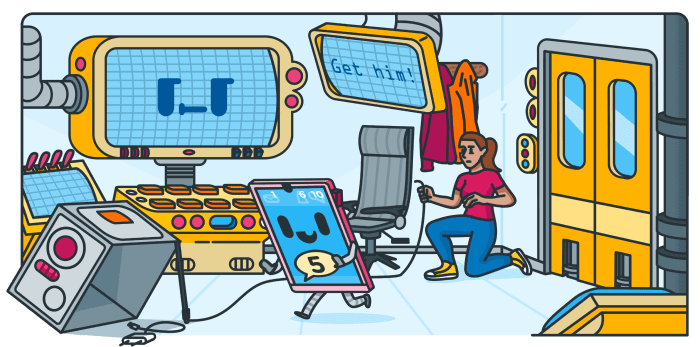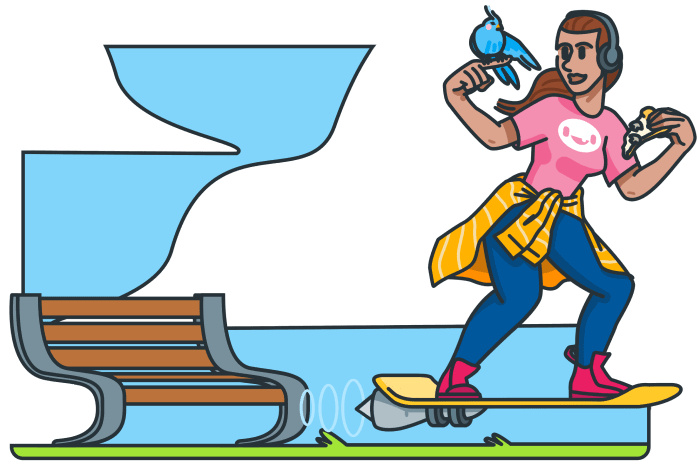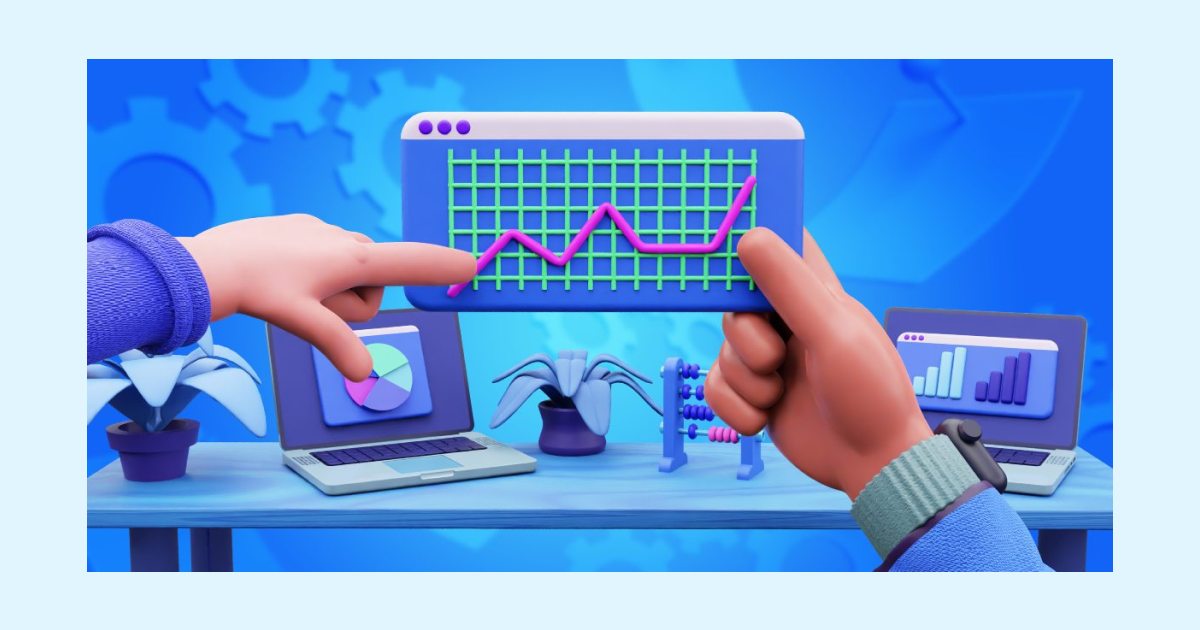How to take back control of your time
Last updated on: March 29, 2023
J.R.R. Tolkien, in the guise of Gandalf the Grey, once said: “All we have to decide is what to do with the time that is given us.”
Yet, how much truth can we find in this statement nowadays? Yes, we all get time in life — but it seems that we are rarely the ones to decide what to do with it.
Emails, house chores, unavoidable errands, excessive workloads, and constant requests from others often make us feel as far away from having control of our lives as possible.
There rarely seems to be enough time to finish everything at work, and once we’re home, we’re too tired to enjoy our free time.
So, we often wonder:
“How do I get more free time to spend with friends, family, or on hobbies?”
“How do I get more time for myself?”
“How do I find time for everything at work?”
“How can I get the most out of 24 hours?”
“How can I get more time throughout the day?”
Or, in other words: “How do I take back control of my time?”

To find answers to these, and related questions, we consulted with professional experts in the field — time management and productivity coaches, mindset and life coaches, therapists, authors who covered related topics, health and wellness coaches, as well as other relevant experts.
For this article, we’ve gathered insights from their professional experience and expertise about what stops people from using time as they want, as well as actionable advice on how best to take back control of your free time and your time at work.
Table of Contents
What is stopping people from spending time as they want?
Before you can take back control of your time in the future, you need to understand what’s taking away from your time at the present. The experts we talked with revealed 9 crucial obstacles that stop people from organizing their time as they want:
Interruptions
According to Frank Buck, the author of Get Organized! Time Management for School Leaders and Global Gurus’ #1 time management professional for the years 2019 and 2020, interruptions are the key culprit that take away from your time at work. Moreover, this problem has only increased over the years:
“A generation ago, if you could control the telephone and drop-in visitors, you could control your time. Today, add email, one or more text messaging apps, and Social Media to that list, just for starters.
In an information-rich environment, we can always read one more tweet, read one more news article, or subscribe to one more online newsletter. The flood of incoming information is the enemy of focus.”
Working around the clock
When it comes to the matters that stop us from spending more time doing the things we love, it turns out that one of the biggest problems is — the inability to shake off work. Here’s how Frank Buck explains it:
“We tend to postpone the things we love to do until we finish the things we have to do. It’s hard enough to finish the things the world has told us we must do. As a result, the things that make life worth living get pushed off the table. We live in a world of abundance unlike anything history has seen. The technology in our pockets makes complex things simple. Still, we find ourselves living in overwhelm.”
The team at We Level Up, whose mission is to help people reach their full potential in terms of lifestyle and goals, attribute this need to work around the clock to financial necessity and a constant need for excellence:
“It’s harder to make a decent income these days and it is tedious to harvest a gainful skillset with how often technology changes. If you aren’t making a solid income, chances are the pressures of our economy are taking a toll on your time management. If you are making a solid income, chances are you are flooded with work and can’t find qualified employees to help with the burden. The emotional and physical labor poured into excelling in today’s world hurts our relationships with friends, family, and ourselves.”
Distractions (and our need for them)
Felicia Broccolo, a certified Life Coach at The Life Coach School, told us that a crucial reason for why we seemingly have so little time to do what we need or want, are little, everyday workplace distractions:
“Checking social media, chatting with a coworker, deciding what you are going to do, etc.”
Personal Productivity Coach & Consultant, Ravindra Kondekar, adds that we turn to distractions as a means to handle a lack of clarifications at work:
“The distractions come in many forms, but the root cause always is that people do not have the worthy alternatives ready to take up, at that moment. People could really do something related to their priority work, but either the actions needed are not clarified or if they are clarified, people do not remember them at the moment when the distraction takes them over.”
Katina Mountanos, mindset coach and author of On Adulting: How Millennials (And Any Human, Really) Can Work Less, Live More and Bend the Rules for Good, further explains that it’s also our need for distractions that causes problems with time use, and not just the distractions themselves:
“In my opinion, the root of our distractions comes down to how our human brain is wired. Our brain’s purpose is to constantly be on the lookout for new stimuli — so keeping your phone physically next to you or your email in the background of your computer creates an environment ripe with stimuli (aka distractions). If we want to really understand our biggest distractions, the cause is not necessarily the stimuli around us, but how our minds react to them.”
A skewed perception of time use and priorities
Katina Mountanos adds another problem to the list — our skewed perception of everyday activities that leads to improper time use:
“Our definition of leisure has shifted so much in the past few decades, and we often bucket work or even survival needs, like sleeping and eating, into “leisure” time.
On the flip side, American adults today spend over 11 hours each day consuming content.
So, we’re spending our time in one of two ways: working or scrolling.”
Kelly Harris Perin, member of the International Coach Federation and founder of Little Bites Coaching invested in helping leaders and teams increase productivity in sustainable, healthy ways, adds that we often cannot decide what our priority work even is:
“The biggest underlying problem for many folks is that they aren’t clear on their priority work. If you aren’t sure what’s most important and why, all tasks can seem equal, and you’ll tend to bop around to whatever shiny new problem pops up, or be more inclined to get pulled away from work to your kids or the news.”
Being overly optimistic about time use
Kelly Harris Perin further explains that it’s unfounded optimism that also makes us overestimate the time it takes us to tackle certain tasks, and subsequently disrupt our schedules:
“We tend to view time management challenges through a deficit lens and think they’re a result of poor boundaries and inefficient work habits. I like to reframe that and think of time management challenges as being rooted in optimism. We want to do all of the things and live our fullest lives, and we’re often just WAY too optimistic about the amount we can squeeze into a day or a week.”
Procrastination
Clovis Chow, an education expert and founder of the educational and student blog
TimeOrganizeStudy that teaches students about time management and productivity, cites procrastination as a big problem in maintaining control over your time.
This is especially true for the people who feel like they have little time to spend doing what they love, like hobbies, spending time with friends and family, or on self-care:
“These people constantly procrastinate or get distracted. As a result, they are unable to complete their tasks until the last minute, where they have no choice but to sacrifice their time for work instead of hobbies. This is the sad reality that many are living day by day.”
Multitasking, i.e. context switching
Time management and productivity coach, Megan Sumrell, cites context-switching as another key productivity problem — especially for women:
“This is when you are moving back and forth between the roles you play (aka employee, mom, business owner, wife, caregiver, etc) all day long. This creates the feeling of being on a hamster wheel all day long while not feeling productive. This is also why so many women don’t have any free time or time for self-care..they are too busy ping-ponging back and forth all day long.”
Sandra Glavan, anxiety expert and founder of Amosuir, further sheds light on the effect multitasking can have on your time use:
“In my experience, multitasking is distracting, ineffective, and inefficient, while also causing unnecessary stress and anxiety. Even if we think we can complete multiple tasks simultaneously, in reality, we cannot be fully present with any of these tasks, which reduces our efficiency and causes distraction. According to research, multitasking can require 40% extra time for completion, compared with focusing on one task at a time. More complex tasks can require even more time.”
Poor planning habits
Felicia Broccolo cites another important factor in improper time use — and it’s improper planning:
“The problem is, most people go into their day with little to no plan regarding what they are going to get done.”
Sandy Rodrigez, the author of Choose to Prevail: Unexpected Insights to Help you Overcome Challenges, adds that having a poor planning system is just as bad as having no planning system at all:
“People often overlook something because they keep separate to-do lists or reminders, and it’s easy to forget to check one of them. They might have a wall calendar, a list on their phone, and scribbles on sticky notes. Who could keep track?”
The reluctance to say “No”
The Resource Director for Test Prep Insight, Psychology-Trained Certified Health and Wellness Coach, and Certified Life and Relationship Coach who frequently writes about the topic of stress and time management, Lynell Ross, explains that it’s our reluctance to say “No” to new tasks that takes control of our time at work:
“Most people have problems focusing on their own priorities because they are distracted by other people, and feel guilty about saying no. Even if you are highly motivated and organized, but allow other people to interrupt you and make their problems yours, you will continue to lose valuable time.”
She explains that we avoid saying “No” because of a fear of being perceived as “selfish” — as a result, we neglect our personal needs in favor of the needs of others:
“If you can’t say no, and learn to disappoint some people, then your needs will get pushed to the bottom of your list. People often think they are supposed to help others even at their own expense because they feel guilty about taking care of themselves.”
Empowerment mindset coach, speaker, author, and meditation teacher, Antoinette Beauchamp, adds that this guilt is actually tied to how we (and others) condition our behavior:
“When we put ourselves and what we love first, it’s easy for people to feel guilty about that choice because we’ve been conditioned (women especially) to be caretakers and put others’ needs before our own.
Yet, in truth, if we take care of ourselves, then we have more energy and compassion to take care of others. Exactly why they tell you to put the oxygen mask on yourself first in an airplane!”
Expert tips on how to take back control of your time

In the previous section, we talked about the problems that stop us from having control of our time — now, let’s look at some solutions.
Here’s what tips experts have to offer when it comes to taking back control of your time at work, and after work:
Tip #1: Take ownership of your time
According to Frank Buck, the key to taking back control of your time at work is taking ownership of your time, by planning it out:
“Start the day with a well-defined short list of what’s important for the day and make everything else get in line. Close the door. Let phone calls roll to voicemail. Nobody is going to protect your time for you, nor should they. It’s up to each of us.”
Personal and Business Mindset Mastery Success Coach and founder of Mindset Mastery Success, E. Marie Hall, also advises this practice for taking back control of the time you could be spending on self-care:
“Run your day — stop letting the day run you.
This means plan out your day, week, and month. Set aside undistracted time each day to address the important areas of your life (Career, Finances, Health, Relationships, Spirituality).
Your self-care must be prioritized and that means scheduled. When we make it non-negotiable there’s no room for excuses. When we take care of ourselves first, we have more to give others. Nothing can be poured from an empty cup.”
Tip #2: Be precise when planning your time
So, we already talked about how important it is to take ownership of your time by planning it. But, according to Felicia Broccolo, a crucial factor in that planning is deciding how much time you want to spend on each task, precisely:
“Parkinson’s law states that “work expands so as to fill the time available for its completion,” (i.e. if you have an hour to do something, it takes you an hour, if you have all day, it takes you all day).
My tips for taking back time at work and at home are the same.
Before you do anything on Monday morning, take one hour to write down everything you need to do that week (work and otherwise) and write down in a planner or calendar exactly when you are going to do that thing and how long it will take you.
You’ll be surprised by how much you can get done.
If you only have 30 minutes to do something, all of a sudden it’s harder to justify scrolling through Instagram.
Remember, your problem isn’t about having enough time, it’s about having enough focus.”
Alisha Powell, a therapist at Amethyst Counseling and Consulting, further advises that you plan your work hours, by the hour, in a time-blocked calendar:
“I have a calendar that has hour slots and I can write down exactly what tasks I have to complete for the day. I use it to schedule appointments, errands, and tasks so that I can stay organized. I also write down my tasks by order of priority so that I can leave room for the unexpected and stay flexible when something comes up.”
💡 Are you a manager or supervisor who needs to worry about scheduling employee time on a regular basis, apart from organizing your own time? Check out our guide to scheduling employee time, and try our free scheduling templates that will help you plan and schedule employee time on a daily, weekly, bi-weekly, monthly, or yearly basis.
Tip #3: Use one daily planner for everything
Sandy Rodrigez offers a solution that will help you take control of both the activities that need to be done and the ones you want to do and are excited about — a pocket-sized paper day planner that has a full blank page for every day of the year:
“Every time I need or want to do an activity, I write it down. Be it running an errand, calling a friend, attending a meeting, doing the dishes, or going to the movies, in it goes.
I write down birthdays and important dates on the proper pages; so I don’t need social media to alert me.”
If anything must be done by a certain date, I’ll add advance reminders.
If a payment needs to be in by the 10th of every month, I will write that on the page meant for the 10th, but I’ll also write “bill must be paid by 10th” on a previous page, such as the one for the 8th.
When it makes sense, I break down activities into manageable chunks.
Rather than writing “file taxes” on one page, I divide that into steps like “set up appointment with preparer,” “track down receipts,” etc., each one on its own page.
I schedule activities I enjoy for weekdays. This avoids the trap of saving whatever brings you happiness for weekends only, and helps you live every day to the fullest.
My technique requires everything to go into one book. When you look at all of your appointments and activities, you feel in-demand and productive, and crossing items off the list is rewarding.
This system prevents stress.
I feel no anxiety about things that need to happen since they’re all written down where they can easily be accessed. Since I don’t have to struggle to remember that information, I can put any activity not at hand completely out of my mind. This creates more space for creativity and relaxation.”
Tip #4: Understand how you spend time at work
“The first thing I recommend doing is a time evaluation by recording what you are doing every minute of the day for a week,” says Amalie Shaffer, co-owner of Systematic Excellence Consulting and certified advisor whose duties include helping business owners improve efficiency in their business and private lives:
“It is tedious but once we know where we are spending our time we can assess where things can change.”
Katina Mountanos further explains why understanding where you spend time is important for reclaiming control of your time at work, especially in terms of the time you may be wasting on distractions:
“I think it’s really important to get honest about your working style. Most people don’t truly understand how much time they spend engaging in these stimuli, or distractions, on a daily basis.
So, if you often feel distracted or sidetracked but don’t know why I suggest trying a little experiment on yourself.
Whether it’s for one day or an entire week, keep track of how you truly spend your time during the workday.
How often do you check your phone while working in front of your computer?
How many times do you take “breaks” in the kitchen?
None of these actions are necessarily bad per se, but getting clear about what your day looks like is the first step towards making change.
From there, you can analyze your biggest time culprits and make small shifts to change your working environment, like keeping your phone in another room, or setting aside specific times of the day to take snack breaks.
It all comes down to staying flexible and honest with yourself.”
Tip #5: Understand how much free time you have
Katina Mountanos further emphasizes why it’s important to understand how you spend your free time as well:
“My number 1 tip for taking control of your free time is similar to my recommendation above — get really, really clear about how you spend your time right now.
You might be surprised to find that you have a lot more time than you think, but you’re spending it in ways that are draining rather than fulfilling.
After getting really clear about what your time looks like, create a list of activities that would really bring you joy — maybe ones you haven’t done since you were a kid, like painting or dancing. Set aside a small amount of time each week to experiment with these practices so you can turn them into a habit.”
💡 To evaluate the time you spend on tasks and distractions, but also the time you could be spending on leisure activities, you can try Clockify, our time tracker and time management app. Sign up for a free account here.
Tip #6: Review and revise your current work schedule
“For many of us with packed calendars, moving through a week can feel like a game of calendar Tetris — moving appointments, shortening meetings, and trying to squeeze more and more in”, says Kelly Harris Perin. She proposes you think about how you schedule your work time now, in order to establish a better workflow in the future:
“I recommend taking a step back from Tetris, printing out a blank weekly calendar, and taking some time to sketch out your ‘ideal but real’ weekly flow. Start with your work hours:
What’s a reasonable start and stop time for you?
Do you want to work out a few times a week at lunchtime, or need to take off from 3-4 pm every day to play with your kids when they’re done with school?
What’s your ideal flow of meetings — many in a row or all spread out?
Do you need to protect time for deep work like writing or data analysis?
You might not be anywhere close to your ideal-but-real weekly flow YET, but having it in mind can help you nudge closer to it over time.”
Tip #7: Always start your workday with the right tasks
Ray Zinn, Silicon Valley’s longest-serving CEO, author of Tough Things First and Zen of Zinn, and founder and former CEO of Micrel Semiconductor, told us that the trick to taking your time back at work is working on the more challenging tasks early in the day:
“My number one tip for taking back work time is to always do the tough things first. By doing so, you clear the biggest boulders first and set the tone for a more productive day.
You also learn discipline which builds on itself, enabling you to become more and more skilled at tasks that you likely used to hate. When you learn to love the things you used to hate, you take back more and more time and become far more productive than you thought possible.
This one strategy enabled me to run Micrel Semiconductor for 37 years, 36 which were profitable.”
Tip #8: Take a break from digital devices
Digital devices are infamous time-wasters — and we often turn to them because we are bored. But, boredom can be an opportunity for reclaiming your time, instead of a nuisance, as explained by Manoush Zomorodi in her book Bored and Brilliant: How Spacing Out Can Unlock Your Most Productive and Creative Self:
“Boredom is the gateway to mind-wandering, which helps our brains create those new connections that can solve anything from planning dinner to a breakthrough in combating global warming.”
In order to obtain more time to be “bored” and put your use of digital devices under control, she writes about 7 challenges you can tackle:
- Observe yourself — in this challenge, you should aim to track and understand your digital habits to see how you use your digital devices in the first place.
- Keep your devices out of reach while in motion — in this challenge, you should keep your phone out of sight while you are walking, driving, or are otherwise in transit.
- Photo-free day — in this challenge, you should refrain from taking any pictures.
- Delete that app — in this challenge, you should take one app you think you can’t live without, and simply delete it.
- Take a fake vacation, i.e. a “facation” — in this challenge, you should disconnect from all communication apps and systems while at the office.
- Observe something else —in this challenge, you should make the effort to notice something other than your phone that’s interesting in your environment.
- The bored and brilliant challenge — in this challenge, as the culmination of the previous challenges, you should use your newfound “boredom” caused by the minimized use of your digital devices, to make better sense of your life and set goals accordingly.
Tip #9: Stop checking your inbox all the time
According to experts cited in our 2020 study on the time spent doing recurring tasks, people spend 28% of their time at work managing emails. In total, that leads to anywhere between 1.5 and 2.5 hours spent reading and replying to emails.
Moreover, research and experts, such as the ones we’ve cited in our workaholism-related statistics, show that we have difficulties resisting the urge to check emails, even after work. Let’s take the UK employees as an example:
- 57% check emails during the weekends
- 30% check emails throughout the night
- 23% check emails while on vacation
- 20% check emails while in bed
- 16% can’t eat without checking their emails
As a solution to getting back control of this time, Frank Buck proposes a structured approach to handling emails:
“Turn off email notifications. A few times during the day, handle every email in one batch. An empty email inbox is not only possible, it’s a necessity for achieving peace of mind. We teach people how to treat us. If we respond to every question immediately, we teach people they can wait until the last minute and we will drop everything to handle their request.”
Tip #10: Prioritize your needs through Intuitive Scheduling
“The idea of prioritizing your free time can sometimes feel selfish or daunting, but this is ultimately a mindful tool to keep your energy high so that you’re spreading your positive energy with others.”, Antoinette Beauchamp begins to explain how you can implement Intuitive Scheduling, a productivity technique she invented, in order to prioritize your free time.
According to the definition, Intuitive Scheduling is “a heart-centered methodology where you plan your days according to what would bring you the most joy and ease — it goes hand-in-hand with connecting to yourself to understand what your needs are, personally and professionally”.
Here’s how Antoinette illustrates it:
“If you’re tired, allow yourself to rest. If you know you need to eat 5x a day, always have snacks nearby. If you know you get burnt out from meetings, then schedule them further apart.
Start by taking inventory of your day and noticing how certain habits and routines affect you. With this intuitive knowledge, you can manipulate and adjust your schedule to suit your unique needs — and it may be different each day!
By giving yourself permission to shift and go with the flow intuitively, you are also giving yourself more space to discover motivation, gain confidence, and refine your version of productivity.
So, to control your free time, it’s all about listening to your gut and giving yourself space. That’s why intuitive scheduling is so empowering. It gives you your power back when it comes to your free time and how you want to spend it.
By prioritizing your needs and what your intuition says is best for you at the moment, it supports the greater good by shifting the energy around you.
Something we all need right now!”
Tip #11: Ask for help from others
Melissa Kepler, Strengths Coach at Capital Humans where she focuses on helping people achieve personal growth, proposes another interesting approach that should help you succeed in prioritizing your own needs. Simply, mask your own needs as requests from others — in order to make them seem non-negotiable:
“I find that people often make a silent mental distinction between requests made of them by *others *and requests they make of *themselves*.
Requests from other people — the deadline from your boss, or the two dozen cupcakes for the bake sale — feel non-negotiable.
Requests from yourself — to get more sleep, or take some time to paint, or actually go jogging – feel fake and low-priority.
My tip, if this resonates with you, is to hack your brain by having someone else give you the request — but they have to actually mean it.
If your best friend begs you, for *her *sake, to please come out to brunch with her to catch up, it’s no longer something you can ignore. It’s a request from someone else.
If your boss *insists *you take a day off to recharge before a big project starts, that’s not something you can deny. It’s not selfish — it’s necessary!”
Tip #12: Learn how to say “No”
“In order to live a well-intentioned life, we must learn the art of saying no!”, explains Warren Wong, blog founder and author whose mission is to inspire and teach 1 million people to take control of their lives and do what they love:
“While fumbling to get ready for work, juggling spouse and children, we forget what is important in our lives. We lose track of our health, relationships, and start feeling lost in the day to day grind.
Our most valuable resources are time and energy. Be very protective of both!
If there is a person that drains your time and energy, avoid them or politely decline their invitation.
If there is a job that is draining your youth and mental sanity, then it may be time to start a job search.
If you absolutely hate that book you’re reading, then it’s time to say no, and find another one.
Saying no is simple, yet powerful. It requires 1 part courage, 1 part self-awareness, and 1 part self-love.”
E. Marie Hall further suggests taking the time to decide what types of requests and tasks to say “No” to:
“Make a list of tasks that can be eliminated and/or designated.
And, if you don’t think this is possible ask yourself: “If my life depended on it, could I let go?”
Most likely the answer would be YES. And, the quality of your life DOES depend on it, so start with self-management!”
As another solution to making it easier to say “No”, Lynell Ross suggests simply planning your work on a larger scale:
“Prioritize each day, working backward from your end goals. Look at your larger objectives, then break out your months, weeks and days into action steps with deadline dates. Once you know what you need to do, you will be much better at saying “No” to people who interrupt you or ask you to do things for them.”
Tip #13: Battle your multitasking habits
When it comes to the time-consuming problem of multitasking (i.e. context switching), Megan Sumrell advises you battle it by defining time blocks for your activities:
“When you learn how to create the right type of type blocks in your day to minimize context switching, it opens the doors to massive time freedom!”
To further help you avoid multitasking, Sandra Glavan advises you to outline your priority tasks and focus on them first:
“The only way you can take control of your time is to write an updated priorities list each day. We can have hundreds of tasks that we need to complete, but in order to start getting through these effectively, we always need to focus on the priorities first.
I always write my new list of priorities at the end of each working day, while everything is still fresh in my mind. Then, each morning, when I start work, I have my priorities already outlined, and I don’t start anything else until they are done!
I have learned that this is highly effective for increasing productivity!”
Tip #14: Establish a distraction-free environment for work
As a great tactic to help you minimize time-consuming distractions, Clovis Chow advises you create a suitable environment to work in:
“My #1 tip would be for one to find and create an optimal working environment for themselves, free of any distractions.
This can be putting their gadgets outside their room where they cannot see or hear any notifications or simply finding a nice quiet place where they can focus.”
When it comes to the devices you need for work, Megan Sumrell advises turning off push notifications on your apps when you want to fully focus on an important task, and returning to them at a later time:
“The first thing I tell my clients to do is to turn off ALL notifications on their devices (phone, tablet, and computer).
Then, create set times during the day where you check in on email, messages, alerts, etc.”
And, if you cannot resist browsing Social Media from time to time, Alisha Powell advises you do it in time blocks — the way she personally approaches this time suck:
“I make it a point to only get on social media in 5-minute time frames and once my alarm goes off I resume my other tasks.”
💡 A great solution to implementing such 5-minute breaks for Social Media is the Pomodoro time management technique — you work in 25-minute work blocks and then switch to 5-minute break blocks, before resuming work on another 25-minute work block. To implement this technique in your own routine, you can try the Pomodoro timer within Clockify’s browser extensions for Chrome and Firefox, or on Clockify for Mac.
Tip #15: Schedule your breaks
Antoinette Beauchamp advises that you schedule your breaks, in order to make sure you reclaim some of your time at work:
“It’s allllllllll about creating mindful breaks in your calendar. Look at your schedule and make incremental breaks, anywhere from 5-30 minutes, throughout your work week calendar.
When you have that 5-30 minutes free, check-in with yourself. Track your mood throughout your day. What are you feeling at that moment? What on your joy list do you feel you want to dive into? What do your mind and body need?
If you maintain these boundaries, you will find that your motivation will increase and your productivity because all of these small breaks are like a reset on your energy.”
Tip #16: Schedule your free time
If scheduling your tasks is key to making sure you work on all your priority tasks at work, it’s no wonder experts agree that scheduling is also key to making sure you have enough time (and motivation) for your leisure activities after work:
Lynell Ross advises you officially schedule select leisure activities in a calendar — and then stick to the said schedule at all costs:
“Allow blocks of time for exercise, resting, having fun with friends, and doing activities you love.
Keep these appointments with yourself as diligently as you would a doctor or business appointment.”
Amalie Shaffer agrees that time blocking is an efficient solution to scheduling your free time:
“It forces us to create appointments for all the things we want to accomplish in a day. When we don’t set time aside for things it is too easy to push it off and do it another time.”
Katine Mountanos adds that scheduling fun activities makes them even more enjoyable, and makes them equal to work tasks in terms of importance:
““Scheduling” fun into our calendar makes that event 30% more enjoyable than if it was simply spontaneous.
And that way, we can give those activities the same respect as we would a meeting or hours spent on the couch scrolling through Instagram.”
Clovis Chow emphasizes the importance of scheduling as a means for battling procrastination, and making sure your time is well-spent:
“Honestly, if there is no schedule for people to follow, they would simply waste time until the last minute. By having a schedule, they know when to work and when to rest, ensuring a good balance of both.”
Kimberly Duff, a Licensed Professional Counselor and a Certified Rehabilitation Counselor the owner of an online private counseling practice at Overcomers Counseling, further advises you schedule your self-care activity or hobby at the same time as another, suitable personal obligation:
“For example, a mom could work on her cross-stitch project weekly at the same day and time while she is waiting for a child to finish soccer practice.”
Tip #17: Pick a priority leisure activity and commit to it
We often have several leisure activities we want to enjoy on a weekly basis. But, we may not have time for all of them. Antoinette Beauchamp proposes you highlight everything that makes you happy and then select one priority among these leisure activities that you will find time for no matter what:
“Write a list of everything that brings you joy and makes you feel at ease— this can be something as small as “drinking a cup of tea outside” or “talking to my best friend.”
Commit to doing at least one thing on this list a day, and use it as a resource whenever you need a mental, physical, or emotional boost.”
Kelly Harris Perin agrees with the practice of singling out one priority leisure activity and adds additional tips that will help you commit to it:
“Start by choosing just one thing that feels important to you and committing to it 100%.
It could be something small- get to my yoga class every Tuesday in November, walk around the block instead of doing email at lunch 3x/week, call 1 friend or family member per day, stay off of work email between 7 pm – 9 am.
Set up a checklist for yourself on your phone, Google doc, or a fancy bullet journal page and commit to tracking your success for at least 2 weeks.
At the end of your 2 weeks, you can celebrate your efforts and decide if you’re ready to add in another commitment.”
Tip #18: Take the time to enjoy small moments
Prianca Naik, a board-certified internal medicine physician and life coach specialized in helping professionals moms build an energized and less stressful life at StressCleanse MD, emphasizes the importance of taking the time to enjoy small moments throughout the day:
“One of the reasons we multitask and do 10 things at once is that we do not take quality time to ourselves. When we actually make time to work out, savor our morning cup of coffee, or meditate, we tend to be more present in what we are doing.”
So, the next time you’re trying to cram dozens of tasks throughout the week, don’t forget to schedule some “me” time as well — and, even more importantly allow yourself to actually enjoy it. Dr. Naik proposes you approach the matter in the following manner:
“Schedule time on your calendar in 10 minute blocks several times a week to do something nice for yourself. (If you don’t do it, no one will).”
Tip #19: Make your tasks less urgent
In order to save more time for leisure activities, Ravindra Kondekar proposes implementing a modified approach to The Eisenhower Matrix, a time management technique meant to help you highlight and focus on your priorities.
The original technique works as follows:
You divide all your tasks into quadrants, based on their importance and urgency:
- Important and urgent tasks go to Quadrant 1
- Important, but not urgent tasks go to Quadrant 2
- Urgent, but not important tasks go to Quadrant 3
- The tasks that are neither urgent nor important go to Quadrant 4
You work on tasks from Quadrant 1 first, then move on to tasks from Quadrant 2. You delegate tasks from Quadrant 3 and eliminate those from Quadrant 4.
Although most priority tasks fall under Quadrant 1, Ravindra Kondekar suggests planning your work ahead, in such a way that minimize these urgent tasks, and places most of your tasks in Quadrant 2:
“The biggest secret of squeezing out time for doing what people love, which typically is discretionary, is to stay in Quadrant 2 of the Eisenhower Matrix, i.e., doing activities that are important but not urgent.
Activities in Quadrant 1, i.e., important and urgent, take more time than when they are in Quadrant 2.
It’s not just that; people do not have control over their time when they have Quadrant 1 activities.
Further, when you do activities that are in Quadrant 1, you set a vicious cycle of more Quadrant 1 activities. That’s how you lose control of your time totally and the discretionary activities bear the brunt.
Fortunately, a written down list of well-defined actions towards your goals is the solution here too as it would help people to stay in Quadrant 2.”
Conclusion
Taking back control of your time may seem like a challenge, due to a constant string of interruptions, distractions, and other problems that come your way to stop you from carrying out your day as you intended.
But, if you take extra time to schedule everything you want to do, from work tasks to leisure activities, rethink what you view as priority tasks, as well as make the extra effort to prioritize your own needs, you’ll make great progress towards spending your time at work, and after work, in a way that’s best for you.





